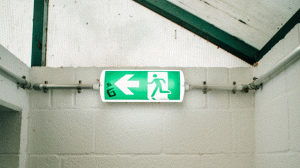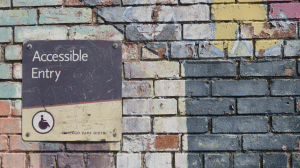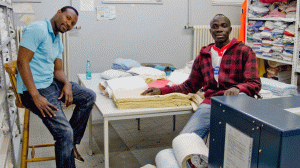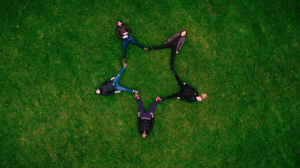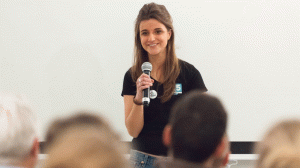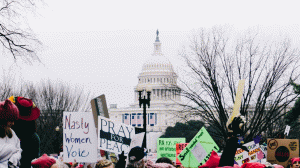Header: Denys Nevozhai via Unsplash.
"to belonging" is a long-term project driven by tbd* that aims to change the discourse around diversity and inclusion to one of belonging. Anti-racism, feminism and equity will be the focus of our work and should lead to a radical systemic change in the impact sector, from "power over" and "power for" to "power with". This content series is a part of this project and is made possible by the Open Society Foundations. In this article, our columnist – diversity & inclusion consultant –Margherita Sgorbissa reflects on the (non-)visibility of women and why it has a bland connotation.
Women today are "everywhere". Female initiatives, women in *add a sector*, women of *add a company*, women *add a traditionally male-white-cis dominated role in the world of work*. Yet why does it seem that their hypervisibility is an act of performance?
Women are everywhere, they are constantly dragged and pushed here and there to the forefront of different world’ stages almost like puppets. It feels like their “being” contains an undifferentiated, symbolic hymn for the liberation from gender-based oppression.
Having a "women whatsoever" (women in Tech, women in consulting, women entrepreneurs, women in engineering, women in science, female founders, female leaders, etc ...), especially in organizational or business spaces, seems to be an must-have requirement for box-checking the diversity agenda, but in reality it portrays a (not so) subtle conscience-cleaning mechanism, especially for those who are not ready to go any further.
I have stumbled upon numerous panels, events, projects, businesses and initiatives to promote women in a given sector or company.
Many of these initiatives target female-only audiences and/or female-led businesses and are primarily chasing a “unique” effort towards what they often call “female empowerment”.
Somewhere between mainstream feminist slogans and (often rather clumsy) attempts to push for gender equality and gender diversity, these initiatives are received well and do not raise suspicion or call for critical perspectives.
Rather, they are supported with optimism and perceived as fully harmless, exemplary and totally necessary.
But... if we are to unpack the pink-washing vitrine, an important first question emerges: Who are the women behind the "women whatsoever"?
Who qualifies as "female"?
Who do these spaces belong to and who is eligible to inhabit them?
If the "women whatsoever" in every space (especially private sector’s workplaces and entrepreneurial projects) is a flag waving at a conquest, to which "folk" does this flag belong? What and who is the conquest really about?
I ask myself these questions because looking at the events, the speakers, the founders, promoters and joiners, almost always the audience is populated by one woman-persona: the white, European/Western, cis, able-bodied, “young” or “young-looking” to middle-age, most likely with a high education level and from a relatively advantaged socio-economic background.
So, what’s wrong with that?
When "women in", "women of", "female *roles*" initiatives are promoted but the diversity of the female experiential spectrum is not expanded, openly reflected and represented, there is a (not so) subtle message speaking for an exclusive, elitist system in which not all women automatically belong to that category.
Offering visibility to a single womanhood model means creating a normative paradigm of the female experience and thus reproducing a systematic marginalization mechanism for those who are "different".
If in promoting gender diversity and gender equality we postulate that the "woman" is only the normative version of a [white, Western/European, able-bodied, cis, “young” to middle aged, child-free and part of the middle-income socio-economic background] woman, we are not only unifying the female experience, but also reproducing a paradigm of normativity, a hierarchy of respectability and belonging that is often dictated by the same patriarchal structures we claim to fight against.
Men and women who promote these sorts of initiatives need to look deeper. Because this type of exclusionary approach is problematic in several ways.
It has a performative and tokenistic character.
It fails to integrate an intersectional perspective in the way we include all the women when we define “womanhood”.
It reproduces the gender binary.
It diminishes the diversity of voices and experiences (i.e. where are the trans women? Where are the women with disabilities? Where are the black women? Where are the queer women? Where are the female-identifying individuals with caring responsibilities, mothers, and other caregivers?) and therefore also conflates the levels of difficulty that each specific experience of the female spectrum brings with it.
It unifies the female experience and simplifies the approach to solving a much more complex issue.
It does not respect any accountability canons that promoting groups should embrace when embarking on these initiatives.
But above all it implies a worrying dynamic: trying to dabble the diversity & inclusion issues by replacing the most privileged dominant group (the white, Western/European, able-bodied, cis, middle-age man) with the dominant group that – in the pyramid of privileged groups – comes immediately afterwards, the white, Western/European, able-bodied, cis, middle-age women.
What I want to say is that talking about diversity and equality is talking about a complex matrix that often manifests itself in a matryoshka model.
If we really care about, and aim to advocate for, gender equality and female*-empowerment, we must be willing to explore it in 360 degrees and unpack its complexity.
Especially for the white women who often lead the change: moving beyond the trap of a feminism that benefits the “normative” woman only, there is so much more (and better) we can do to make sure that this space is a space of belonging for all of us.
If you are championing gender diversity and gender equality, especially white men and women from privileged backgrounds, I invite you to ask the following questions before promoting initiatives and project:
- Who are the women who will be more likely to show up and benefit from what we are offering?
- Is our initiative welcoming trans women and non-binary individuals? If not, how can we make sure they feel they belong to the space we are creating?
- Is our team or speakers’ panel predominantly white and/or male? Does it show a lack of diversity in its composition? If so, what can we do to diversify it?
- Is the issue we’re trying to tackle affecting all women in the same way? (Spoiler: the answer is no!). How can we make sure to unpack the issue on a deeper level and to offer support to diverse female*-identifying audiences?
- Is our language, communication and brand tone exclusionary? Does it use feminist slogans or does it effectively speak for an intention of serving inclusive feminist causes and issues?
You can read more about white feminism, performative diversity and relevant projects and organizations here.
About
Margherita Sgorbissa – Diversity & Inclusion Consultant – is on of tbd*’s columnists for the content series of “To Belonging”. The content in this series is supported by the Open Society Foundations. “To belonging” is designed to change the conversation around diversity and inclusion to one of “belonging”. It centres anti-racism, feminism and equity and calls for a radical systemic overhaul of the purpose sector from “power for” and “power over” towards “power with”.
Check out her website to (un)learn more: www.thisfairforce.com


